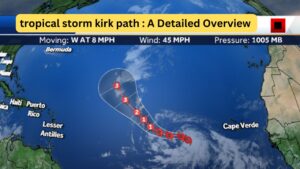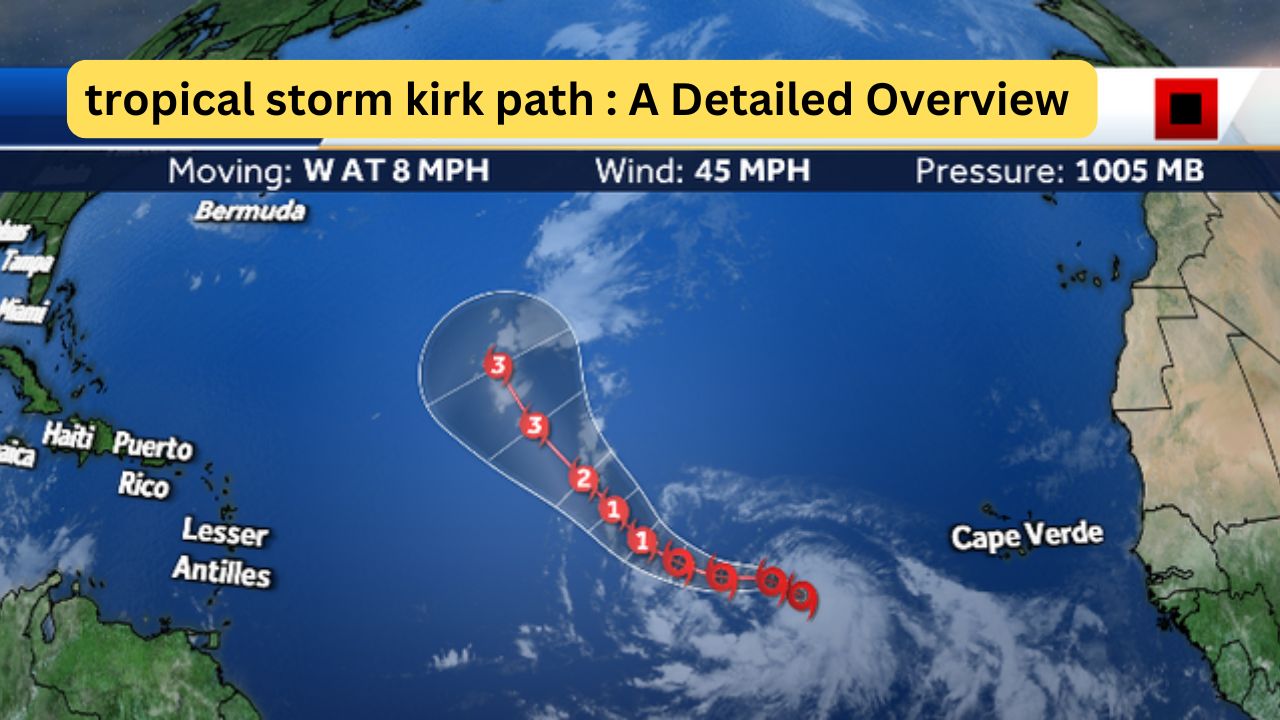Tracking Tropical Storm Kirk: Path, Updates, and Predictions
Tropical Storm Kirk is a significant weather event that has drawn attention across the Caribbean and the southeastern United States. Understanding the trajectory of this storm is crucial for preparedness and safety measures. Below, we offer a comprehensive and detailed guide on the path of Tropical Storm Kirk, key updates, and the latest predictions. With weather patterns constantly evolving, staying informed about the developments of Kirk can be the difference between safety and disaster.
Tropical Storm Kirk: Current Status and Overview
As of the latest updates, Tropical Storm Kirk has formed over the warm waters of the Atlantic Ocean, gaining strength as it moves westward. This storm originated from a tropical depression and has gradually intensified due to favorable weather conditions, such as warm sea surface temperatures and low wind shear. These factors have accelerated the formation of a well-defined low-pressure system, allowing Kirk to gain organization and sustain wind speeds of up to 60 mph (97 km/h).

The National Hurricane Center (NHC) has issued advisories on the path and intensity of Kirk, warning coastal regions in its projected path. Communities from the Windward Islands to the Leeward Islands are particularly at risk, with heavy rainfall, strong winds, and dangerous surf conditions expected in the coming days.
Predicted Path of Tropical Storm Kirk
Meteorological models suggest that Tropical Storm Kirk will continue its west-northwest trajectory over the next several days. The storm’s track takes it through the Caribbean Sea, with possible impacts on Barbados, Saint Lucia, and Martinique. Depending on future interactions with other weather systems, Kirk may either maintain its strength or weaken as it approaches the Lesser Antilles.
Key Locations in the Storm’s Path:
- Windward Islands: Initial landfall is expected in this area, with sustained winds reaching tropical storm levels. Local authorities have advised residents to prepare for potential flooding and power outages.
- Leeward Islands: As the storm progresses, it may continue to affect the Leeward Islands, causing dangerous coastal conditions, flash floods, and landslides in mountainous regions.
- Southeastern United States: Although the exact track remains uncertain, if Kirk continues westward, it could eventually impact parts of Florida and the southeastern United States. Evacuation and preparedness plans are being considered as the storm evolves.
Impact of Tropical Storm Kirk on Coastal Communities
Wind Speeds and Storm Surge
Tropical Storm Kirk’s current wind speeds are estimated at around 60 mph, with potential gusts reaching higher levels in certain areas. This level of wind speed can result in structural damage, particularly to unfortified buildings, and could cause widespread power outages. The storm surge generated by Kirk is also a serious concern, especially for low-lying coastal areas.
Rainfall and Flooding Risks
Rainfall associated with Tropical Storm Kirk is predicted to be intense, with some areas experiencing over 6 inches of rain. This deluge can lead to dangerous flash flooding, particularly in urban areas with poor drainage systems. Rivers and streams may overflow, leading to road closures and localized disasters. Mudslides in mountainous regions like those in Saint Lucia and Dominica could become a significant threat.
Marine Conditions and Rip Currents
One of the major hazards associated with Kirk is the potential for dangerous marine conditions. Rip currents and large swells will impact the coastlines of affected regions, making swimming and boating dangerous. Fishermen and residents near the shore are advised to avoid the water as conditions deteriorate.
-
Tropical Storm Kirk Path Preparedness and Safety Measures for Affected Areas
Evacuations and Emergency Response
Governments in the Caribbean have already issued warnings to residents in the storm’s path. Emergency shelters are being prepared, and officials are encouraging residents to secure their homes, stock up on essential supplies, and prepare evacuation plans. Travel to and from the affected areas is likely to be disrupted, with some flights already being canceled.
Storm-Proofing Homes and Buildings
Residents are advised to take steps to protect their property by reinforcing windows, securing loose objects, and ensuring that roofing materials are properly anchored. Tropical storm-force winds can cause debris to become hazardous projectiles, so it’s crucial that outdoor furniture and equipment be brought indoors or tied down.
Communication and Emergency Updates
Staying informed is essential during a tropical storm. Residents should regularly check the NHC’s advisories and local weather forecasts. Setting up alerts on phones and radios will ensure that important information about the storm’s progression and safety measures are received in real-time.
Tropical Storm Kirk: Long-Term Outlook and Potential Hurricane Development
While Tropical Storm Kirk is currently classified as a tropical storm, there is potential for it to strengthen into a hurricane if conditions remain favorable. However, there are also scenarios in which Kirk could weaken as it encounters dry air or cooler waters. The long-term forecast remains uncertain, but meteorologists are closely monitoring the storm’s behavior.
Factors Influencing Storm Development:
- Sea Surface Temperatures: The warm waters of the Caribbean Sea provide the fuel needed for Kirk to maintain or increase its intensity.
- Wind Shear: Low wind shear is currently allowing Kirk to organize, but if shear increases, it could disrupt the storm’s development.
- Atmospheric Moisture: Dry air from nearby weather systems could infiltrate Kirk’s core, reducing its ability to intensify.
Global Response and Assistance
International aid organizations and regional disaster management authorities are on high alert. Humanitarian aid, including food, water, and medical supplies, is being prepared for swift deployment to areas that may be hardest hit by Tropical Storm Kirk.
Tropical Storm Kirk Path The United Nations Office for the Coordination of Humanitarian Affairs (OCHA) has already activated response teams in case immediate assistance is required. Additionally, organizations such as the Red Cross are coordinating efforts with local governments to ensure that vulnerable populations receive the support they need.
Conclusion: Prepare for Tropical Storm Kirk’s Impact
As Tropical Storm Kirk continues to move through the Atlantic and toward the Caribbean, it’s crucial for residents in the storm’s projected path to stay vigilant. Early preparation and awareness are key in mitigating the dangers associated with this storm. Keeping updated with the latest forecasts from the NHC and local authorities will help individuals and communities stay safe.
Tropical Storm Kirk Path #tropical storm kirk#tropical storm#tropical update#tropical storm joyce#tropical storm helene#tropical storm helene update#tropical storm helene 2024#tropical weather#tropical#tropical storm kirk 2024#tropical storm joyce path#tropical storm helene path#tropical storm bret#tropical storm isaac#tropical storm sally#tropical storm kirk saint lucia#tropical storm leslie#tropical storm helene atlanta#tropical storm isaac 2024#tropical storm joyce 2024
tropical storm kirk
hurricane kirk path
tropical storm kirk path

1 thought on “Tropical Storm Kirk Path : A Detailed Overview”